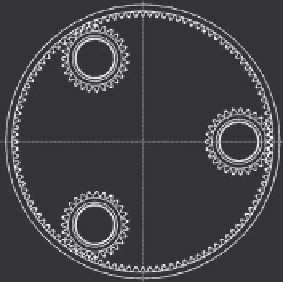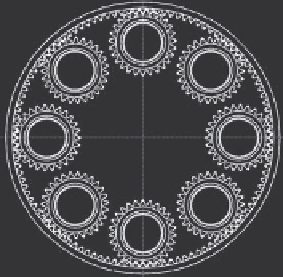Environmental Engineering Reference
In-Depth Information
Various solutions have been used to provide load sharing for epicyclic gears
having more than three planets. The most widely used have employed a fl exible
annulus ring which subject to its tooth forces defl ects as shown in Fig. 6. However,
the maximum number of planets is usually limited to 6, because with greater num-
bers, load sharing becomes less effective as the defl ections decrease. Even though
more planets enable the ring thickness and weight to be appreciably reduced, it is
not enough to give the required defl ections without excessive stresses. In addition,
the planet spindles are straddle mounted in a carrier which requires rigid webs
between the planets to try and minimise its torsional wind up and the mal-distribution
across the meshing faces of the planet wheel teeth.
The main problem associated with fl exible annulus rings is that even with con-
stant torque, they are subject to fully reversed cyclic bending stresses due to the
outward and inward defl ections, with the passage of each planet (see Fig. 7).
The most logical location for fl exibility is in fact the planet spindle. Because it
serves as a mounting for an idler with zero torque, the relative load on the spindle
is always in a constant direction, whether or not the carrier is rotating. It follows
therefore that subject to constant torque, defl ection is static, and not subject to a
Figure 6 : Annulus ring bending defl ections. The defl ection curves should not be
offset laterally but located symmetrically so that they show the radial
inward and outward distortions of the respective 3 and 8 planet annulus
rings from their circular shapes.
Bending
stress
Angular distance between planets
Figure 7: Cyclic stress reversals.






Search WWH ::

Custom Search